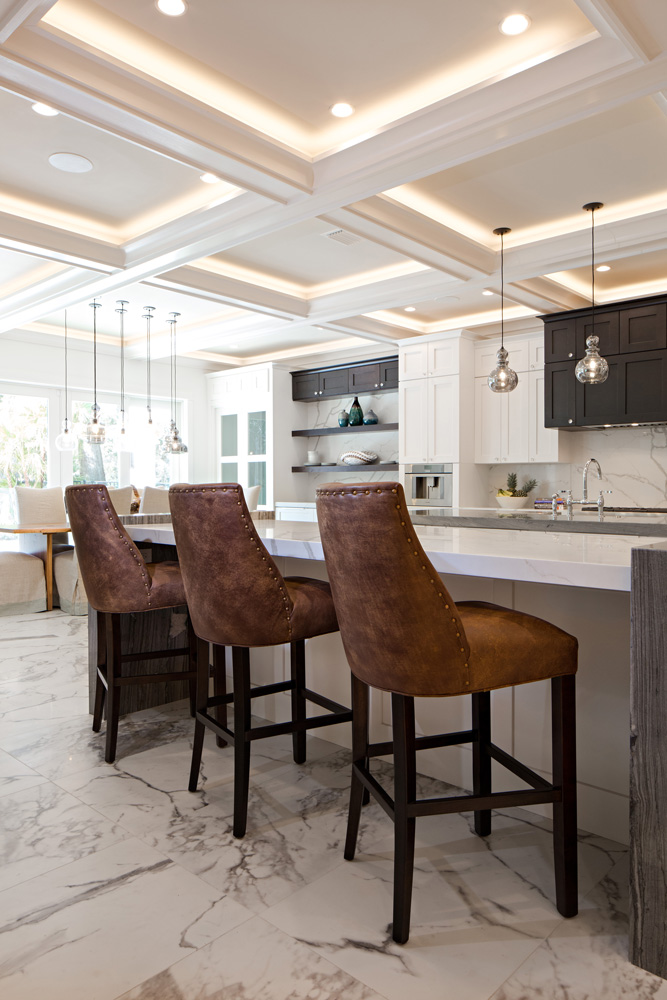Blog
What to Consider When Shopping for Lighting
Lighting can set the tone for how a space looks and feels, which can ultimately affect how you feel. But achieving the vibe you’re looking for while meeting other needs takes thought and consideration. Simply buying the first set of lamps you find to put on your end tables isn’t enough.
Jo-Anne Lucas, a Design Consultant in our Middleton design center, shared that lighting is often the least thought of part of interior design when it “should always be part of the design process.” Whether it’s finding the right fixture size or ensuring there’s ample light in each room, there are a number of factors to check off your list when deciding on the lighting for your home.
Things to consider when shopping for lighting
Natural light

Not only is outside light important, it’s the first thing you should look at when choosing your lighting. If it’s a cloudy day, is additional lighting necessary to brighten up your space?
To get an idea of your home’s natural light, take note of any north-facing and south-facing rooms. A north-facing room could feel cold because there isn’t enough light while a south-facing room may receive an abundance of natural light.
“People should go into their rooms at 2 o’clock in the afternoon,” Jo-Anne shared. “That’s when the light is at its brightest during the day. It doesn’t matter if it’s winter or summer. And so people should go in and see how they feel. That’s going to help you determine if you need more [light].”
Something else to consider: How many windows are in a room and do those windows have shades? If you don’t plan on having window treatments, that’s also when lighting matters.
The room

Whether it’s the kitchen, living room, or even the foyer, the room you’re designing is going to play a major role in the type of fixture you’re going to need. Room size, placement, ceiling height, and the function of that particular space will also influence what you buy.
You should also take into account anything you already know is going into that room. If there’s a piece of artwork you plan on hanging up, bring a photo of it to your designer so they can help you pick out an appropriate wall sconce or picture light.
Read more: Types of Lighting and When to Use Them
Scale and proportion

Something like scale and proportion are important to think about in terms of lighting because they can affect how each fixture compares to the furniture and other objects in a room.
If you have a foyer that goes up to the second floor, you don’t want a chandelier that’s too small for those high ceilings. If you have a large dining table, then a pendant hanging in the center may not only look silly, but it won’t provide ample light. The incorrect size of those fixtures can off-set the visual balance in the rooms they’re going in.
Additionally, appropriate light proportion is going to depend on how you want a space to look and feel. If one half of your living room is lit up while the other sits in complete darkness, it could affect the overall vibe.
Read more: Room Proportion: Creating Scale and Balance When Designing Your Home
Color and other details

Jo-Anne shared that light affects color and other design elements like fabrics, flooring, and countertops.
Velvet, for example, has a lot of lights and darks in it, and seeing it in the right light makes a difference. When you’re walking through a store and there’s a velvet sofa, look at it from the front as well as the sides. Each angle may reveal a different look because of the way the light is hitting the sofa.
The same goes for woods. If you’re looking for a chandelier to hang above your wood dining table, consider how it looks in a showroom vs. how it could look in your own dining room.
To add to that, lighting can show off the different details in a room. If your kitchen has an island with a beautiful granite countertop, highlight it with a pendant light (or pendant lights) up above.
Whether it’s the color you’re painting the bathroom, the type of wood for your kitchen cabinets, or the material of your countertops, letting your designer know these details, and even showing them samples, will help them guide you to the appropriate light fixture.
Lifestyle and function

The way you live and what you need light for is going to influence the lighting you choose for your home. If you work remotely, do you need stronger lights so you’re not straining your eyes by looking at the computer all day? Or if you enjoy watching movies at night, do you need to have a dimmer switch installed with your general lighting to create a moodier vibe?
You could even think of lighting as a sculpture of sorts. If there’s a room in your home that doesn’t have any art or decor on the walls, let your light fixture do the talking. A table lamp with bold colors or an intricate design can grab someone’s attention and act as a focal point.
A couple of final reminders: Choose something you love and have fun! Lighting’s not inexpensive, so always make sure to pick out something that meets your likes and preferences.
Shop for lighting with Circle Furniture
If you’re unsure of where to start with your home’s lighting, we’re here to help! Stop by any of our design centers and one of our Design Consultants will answer your questions and guide you in the right direction.
Author:


